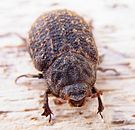Trox sabulosus
| Trox sabulosus | ||||||||||||
|---|---|---|---|---|---|---|---|---|---|---|---|---|

Bone beetle Trox sabulosus |
||||||||||||
| Systematics | ||||||||||||
|
||||||||||||
| Scientific name | ||||||||||||
| Trox sabulosus | ||||||||||||
| ( Linnaeus , 1758) |

|

|
| Fig. 1 top view | Fig. 2 front |

|
|
|
Fig. 3 Wing covers, section, partly tinted green: dot stripes yellow: even intervals red: odd intervals |
|
Trox sabulosus is a beetle from the family of the earth beetles (Trogidae). These were previously placed with the scarab beetles because the antennae are similar in both families. The eight to nine millimeters long animal feeds on animal remains. Occasionally the German names Breitstreifiger Erdkäfer or Bone Beetle are used.
Physique of the beetle
The beetle is brown-black, the antennae rust-red. The bristles, which are often rubbed off with age, are brownish-yellow. The body is short, obovate and strongly arched.
The head is retracted into the pronotum. The antennae have ten links, the last three links form a fan that appears dull due to the fine hair. The first limb of the flagellum is long and slightly hollowed out on the underside. The mouthparts are directed downwards and are not level with the head shield . The upper jaws are short with a small, almost smooth grinding surface. The jaw probes are quite short, the terminal phalanx elongated. The third lip switch element is thickened ovoid.
The pronotum is laterally and at the base (this is the back side, towards the wing covers). At the side it ends with a row of short bristles, at the base there are slightly longer bristles that are less regular. The curved disc is roughly sculpted, deeply dotted and also has rows of bristles.
The wing covers cover the end of the body. Each wing cover has ten strips of flat dimples (partially tinted green in Fig. 3). The stripes are wide compared to other species in the genus, almost as wide as the intervals between the stripes. This explains the German part of the name broadly . In the third, fifth, seventh and ninth spaces (in Fig. 3 partly tinted red) there are larger tubercles, which are covered with short, strong bristles and therefore form large bristle spots. On the straight spaces (in Fig. 3 partially tinted yellow) there are less densely smaller raised areas. They are also bristled and form small bristle dots. In old age the beetle is largely bald (Fig. 1).
The front chest (Prosternum) is extended backwards between the front legs. This prosternal process is short and pointed. The abdomen shows only five sternites . The hips of the middle pair of legs are very small and rounded. The legs have five-part tarsi, the front legs are designed as grave legs due to the serrated outer edge of the rails.
Way of life
The heat-loving beetles can make chirping noises by rubbing their abdomen against the wing covers. The species is not infrequently found in sandy places with sparse vegetation. There they look for dry carrion, old bones, rags, hides, leather, hooves, feathers and bulges. In a French insect forum it is pointed out that the species can be baited well with fox droppings and that the adults can be found in spring.
distribution
The species is distributed almost all over Europe. Overall, almost the entire Palearctic is settled, from Europe to Siberia, Kazakhstan and Mongolia to Korea. Animals from Japan are assigned to the subspecies fujiokai Ochi, 2000. In the south the area includes Asia Minor and Syria.
Taxonomy and systematics
The genus Trox is represented worldwide with 46 species , in Europe with 21 species, all of which belong to the subgenus Trox . About eight species are found in Central Europe. Trox sabulosus is a type of the genus Trox .
The species was first described by Linnaeus in 1758 in the tenth edition of his Systema naturae as the 33rd species of the genus Scarabaeus. The short description is supplemented with the statement “Habitat in Europae terra sabulosa” ( Latin : lives in sandy soil in Europe). This explains the species name sabulosus (Latin sabulōsus = sandy). The genus Trox was split off from Scarabaeus by Fabricius in 1775 . The generic name Trox (from ancient Greek τροξ trox rodent) possibly refers to the fact that the upper jaw is forked ( Latin maxilla bifida)
literature
- Heinz joy , Karl Wilhelm Harde , Gustav Adolf Lohse (ed.): The beetles of Central Europe . tape 8 . Teredilia Heteromera Lamellicornia . Elsevier, Spektrum, Akademischer Verlag, Munich 1969, ISBN 3-8274-0682-X .
- Gustav Jäger (Ed.): CG Calwer 's Käferbuch . K. Thienemanns, Stuttgart 1876, 3rd edition
- Klaus Koch : The Beetles of Central Europe Ecology . 1st edition. tape 2 . Goecke & Evers, Krefeld 1989, ISBN 3-87263-040-7 . P. 348
Individual evidence
- ^ Trox (Trox) sabulosus in Fauna Europaea. Retrieved November 18, 2013
- ↑ Discussion thread on species in Le monde des insectes
- ^ Website of the Coleoptera Poloniae
- ↑ Jiri Zídek (2013): Checklist and bibliography of the Trogidae (Coleoptera: Scarabaeoidea). Insecta Mundi. Paper 819. download
- ↑ Trox in BioLib
- ^ Trox (subgenus) in Fauna Europaea. Retrieved February 10, 2013
- ↑ Tristao Branco (2007): Scarabaeoidea (Coleoptera) of Portugal: genus-group names and Their type species. Zootaxa 1453: 1-31.
- ↑ Sigmund Schenkling: Explanation of the scientific beetle names (species)
- ↑ C.Linnaeus: Systema Naturae per Regna tria naturae, secundum classes, ordines, genera, species, cum characteribus, differentiis, synonymis, locis. Tomus I. Editio decima, reformata Stockholm 1758 first description page 354: 350
- ↑ Sigmund Schenkling: Explanation of the scientific beetle names (genus)
- ^ JC Fabricius: Systema entomologiae, sistens insectorum classes ... Flensburgi, Lipsiae 1775 Original description of the genus Trox as the 3rd genus of the Eleuterata in GDZ on p.21